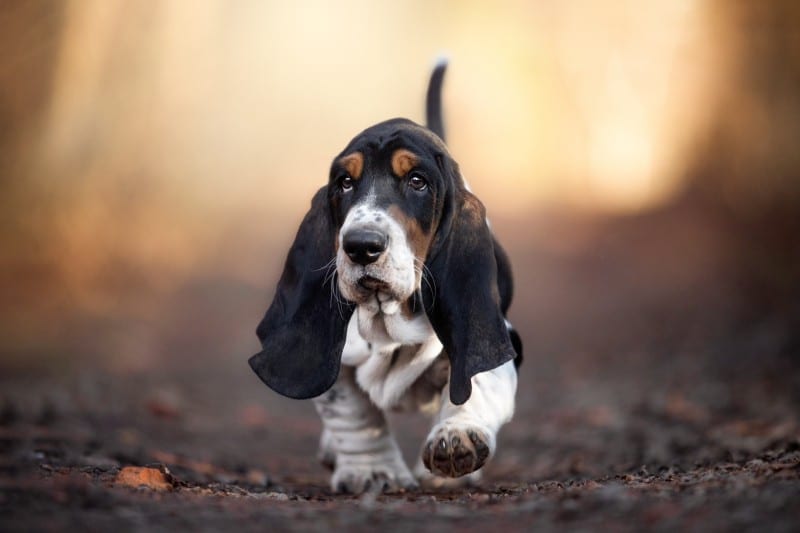In studying any breed, I always turn first to the General Appearance section of the Breed Standard in hopes of finding a concise statement of the breed’s hallmarks and defining characteristics. In the case of the Basset Hound Standard, there are elements that are missing—the looseness of coat and flews that are so characteristic of the breed’s headpiece, and the chest and prosternum, well set into a wrap-around front. However, the General Appearance section does include a number of critical elements of the Basset Hound’s structure, including the often-quoted reference to “a short-legged dog, heavier in bone, size-considered, than any other breed of dog.”
The Basset Hound is an achondroplastic, or dwarf, breed and this has distinct effect on the growth of long bones in young dogs. (The cartilage of the ends of bones grows improperly, compared to dogs with normal length of legs.)
The characteristics of these stunted leg bones include that they are frequently somewhat bowed—what is referred to in the oldest descriptions of Bassets as “crook’d”—and also that they are often stronger than bones of normal length. Short legs with fine bone tend to be straighter than heavier bones, while short legs with heavier bones display the crook that is a characteristic of the Basset Hound.
Basset Hounds, according to breed expert Claudia Orlandi, also display effects of acromegaly, or gigantism, probably derived from Bloodhound breeds well back in Basset history—particularly in their massive leg bones and feet, massive muscles, loose skin around their head, and long, pendulous ears.
When we talk about “heavier in bone, size considered, than any other breed of dog,” we must bear in mind that this is qualified by “size considered.” The Standard does not define a dog preferably no more than 14 inches tall that has the bone mass of a Saint Bernard or an English Mastiff. Instead, what it describes is a dog whose bone is heavy, but in consideration of its overall size.
Since the Basset is a short dog, it doesn’t make sense to assess bone mass in relation to its height. Rather, assess bone mass in relation to the Basset Hound’s length and breadth—its overall body size. Observe bone both in the legs and also in the Basset’s forelegs, which should be “short, powerful, heavy in bone” and in the paw, which is described as “massive, very heavy with tough heavy pads, well rounded and with both feet inclined a trifle outward, balancing the width of the shoulders.”
While references to bone are primarily focused on the front of the Basset in the Standard, it’s important for the overall body to be in balance. This is why the hindquarters are described as “very full and well rounded, and are approximately equal to the shoulders in width. They must not appear slack or light in relation to the overall depth of the body.”
Looking down on the Basset, whether on the ramp or as it is moving on the down and back, the body should appear to fit neatly into a rectangular box, with shoulders and rump equal in width and balanced.
Does the dog appear light-boned or slight? If so, it is a less than ideal example of the breed in this respect. On the other hand, is bone so massive that it appears to interfere with the Basset’s ability to move easily and for long periods in the field? This is a functional problem.
Bear in mind two other phrases in the General Appearance statement: “possesses in marked degree those characteristics which equip it admirably to follow a trail over and through difficult terrain” and “while its movement is deliberate, it is in no sense clumsy.” “Heavier in bone” must be balanced with this emphasis on the Basset Hound’s ability to hunt, often for long days in the field, and to navigate difficult terrain.
The effect of achondroplasia can be seen in the Basset not only in desirable heavy bone and moderate bowing of the legs that creates the breed’s characteristic wrap-around front, but can also be seen in effects that are present in some exhibits and identified as faults in the Standard.
This includes smaller rib cages and short posterior sternums, which are not in accordance with the Standard’s call for “rib structure is long, smooth, and extends well back,” as well as flanged ribs which are called out as a fault. Likewise, being sway-backed is often associated with dwarfism, and this conflicts with the Standard which calls out for a topline “straight, level, and free from any tendency to sag or roach, which are faults.”
Clearly, the Basset Hound is a breed with a distinctive, unusual structure as a dwarf breed that is also a large and substantial breed affected by some characteristics of gigantism. However, in evaluating the Basset Hound exhibit, whether as a judge, breeder or exhibitor assessing the qualities of the competition, always look for the dog’s ability to move functionally and efficiently across varied terrain—both over and under obstructions as needed—in pursuit of fast-moving and agile game.
If you have not taken the opportunity to observe Basset Hounds working in the field, reach out to any of the regional club representatives on the Field Trial Advisory Committee who will be able to let you know of upcoming field trials in your area. In fact, they will likely enthusiastically encourage you to join the gallery and help beat the fields to raise a Tally Ho! A list of the representatives can be found here.
If you have additional questions about assessing substance and bone in Basset Hounds—or any element of the Standard—please don’t hesitate to reach out to the BHCA Judges’ Education Chair, Richard Nance, or other members of the JEC, who will be able to suggest mentors in your area. A list of the JEC Committee Members is available here.
Looking down on the Basset, whether on the ramp or as it is moving on the down and back, the body should appear to fit neatly into a rectangular box, with shoulders and rump equal in width and balanced.
Are you looking for a Basset Hound puppy?
The best way to ensure a long and happy relationship with a purebred dog is to purchase one from a responsible breeder. Not sure where to begin finding a breeder?
Contact the National Parent Club’s Breeder Referral person, which you can find on the AKC Breeder Referral Contacts page.
Want to help rescue and re-home a Basset Hound dog?
Did you know nearly every recognized AKC purebred has a dedicated rescue group? Find your new best friend on the AKC Rescue Network Listing.
Basset Hound Breed Magazine
Showsight Magazine is the only publication to offer dedicated Digital Breed Magazines for ALL recognized AKC Breeds.
Read and learn more about the charming Basset Hound dog breed with articles and information in our Basset Hound Breed Magazine.
Error embedding FlippingBook shortcode, please check the flipbook url. (https://digital.showsightmagazine.com/view/751318/)
If you enjoy the Bassett Hound Breed Magazine, help us educate the community by sharing it.









